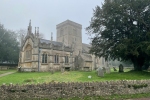July 2015
Vision and Planning
Who Sets the Vision?
The catechism in The Book of Common Prayer says that the mission of the Church is “to restore all people to unity with God and each other in Christ.” What does this look like at the local level – and who in the congregation or faith community sets this vision?
This question has been on my mind for months. It’s a central focus of our work at the Episcopal Church Foundation and a major theme in the recently revised Vestry Resource Guide. In a recent conversation, a colleague shared this blog post in which Methodist pastor John Ed Mathison responds to a question, posed by a new pastor: “Does vision for leadership in the local church come through the pastor or through the congregation? Or is there some other third, fourth, or even fifth option?”
In both posts, the authors frame their response within the context of the United Methodist church polity. While Episcopal and Methodist churches have common roots, there are differences in polity and practice. Our Episcopal polity is that lay people, clergy, and bishops make all major decisions at every level: denominational, diocesan, and parish.
This got us thinking: How might leaders of Episcopal congregations answer this question:
Does vision for leadership in the local church come through the pastor or through the congregation? Or is there some other third, fourth, or even fifth option?
Several lay and clergy leaders were invited to consider this question. Here are the responses I received:
Jan Henderson, senior warden at St. John’s Episcopal Church in Jackson Hole, Wyoming, writes:
“All of the above and none of the above. From ECF’s January 27th webinar “The Leader’s Heart:” the 1st of 10 ways to approach leadership … is to Surround Leadership Efforts in Prayer, which also includes the Father, Son, and Holy Spirit as fundamental in any vision for leadership. That lofty answer said, there are very distinct roles for the pastor and for the congregation. The pastor is a paid professional whose duty it is to continue learning in order to bring fresh ideas, along with experience, to his or her ministry, while it is the lay leadership of a congregation who understands its core values and have the real sense of place. Both are essential to successful leadership, and both must be open to prayerfully listen, discuss, and move forward together, with God’s help.”
Miguelina Howell, vicar at Christ Church Cathedral in Hartford, Connecticut, is a member of the Council of Advice of The Episcopal Church Office for Latino/Hispanic Ministries and served on The Task Force for Reimagining the Episcopal Church, 2012-2015.
“It seems to me that in a healthy setting, vision for leadership in the local church comes in a variety of ways, according to the movement of the Spirit and the capabilities of the Body of Christ in that particular setting. At times, it comes from the clergy and, at times, from lay leadership. It also may come as a combination of both and as a result of collaborative ministry practices, dialogue, and clear understanding of God’s mission and the role of all baptized in the building of God’s kingdom. Additionally, it is important for clergy to have an understanding of God’ s call and to provide leadership to their communities in listening and discerning what God is up to in their context.”
Steve Muncie is rector at Grace Episcopal Church in Brooklyn, New York. In his response, he raised additional questions.
“His [Mathison’s] goal seems to be to maximize the ownership of the vision. But what if the Church is not called to speak with one voice but to speak with many voices? I wonder if the Church is not enriched and empowered by a multivocal rather than a univocal approach to mission and ministry?
“Mathison wants to raise up ‘the vision’ but he is vague about the contours of vision itself. What is the difference between ‘ministry goals’ and ‘godly vision?’ Is vision simply another word for long-term congregational goals or is it biblically and theologically grounded in what the living God is calling the Church to be and to do? As I read the article I kept asking myself, ‘Whose vision?’ For me, the challenge is not only to embrace a proposed vision of a group of parish leaders (the Joel Committee/Board of Stewards) but to continually seek God's vision for God's people. I believe we are able to easily lose sight of God's vision as we become enthralled by our own.
“Our vision may be ministry development, increased membership, and enhanced programs, but God's vision may be justice for the poor, racial reconciliation, nonviolence, and peacemaking, establishing God's reign of Love in every place. God's vision will shatter our own certitudes and our own comfort. God's vision will always extend the margins of grace to make room for those we find it difficult to love. This godly vision will be less programmatic than prophetic - and it very well may cost us deeply held assumptions and cherished comforts.”
Read Steve’s complete response here.
Demi Prentiss is a ministry development specialist and co-author (with J. Fletcher Lowe) of Radical Sending Go to Love and Serve, Morehouse Publishing, October 2015:
“The role of the pastor–whether at the local or judicatory or denominational level—is ‘vision crier.’ The vision for the church is God’s, discerned by the leadership of the church– clergy and lay, paid and unpaid–in community. When the discernment process has been well grounded, the congregation can recognize and affirm God’s voice calling them into the future. With the power of the pulpit, the pastor can proclaim and remind and hold accountable. But if the vision is the pastor’s alone, ‘brought down from the mountain,’ there is great danger that the congregation will not buy in, or will receive the unspoken message that their role is to cheer while the pastor brings the vision to life. That’s a recipe for pastoral burnout and congregational disempowerment—not to mention squandering the opportunity to enliven the whole people of God in partnering with the Holy Spirit.”
Why does this matter?
Steve Muncie articulates what many believe: “In the end, the primary task of clergy and laity is to stay attentive to God’s vision and to see that our local mission is advancing the reign of God.
“God is inviting – challenging – us to see the world with all of its brokenness through the eyes of divine love and mercy. We are called to a broader vision for the loveless, a deeper look at the plight of the powerless. The danger for the Church is to remain blind to God’s great vision while we busy ourselves with our own limited sight, reducing God’s Mission in the world to our maintenance of the local church.
“The local church and its ministries are vitally important to building up the people of God. We need to make plans and establish priorities for strengthening congregational ministry. We need structure and accountability. We need to maximize participation in sharing the vision.
“However, God’s great vision is still waiting to be seen by those who have eyes to see.”
Try This
What processes do the leaders of your congregation use to discern God’s great vision? In his response, Steve Muncie shares the visioning practice used at Grace Episcopal Church:
“I invited the entire congregation to a "Share the Vision" process. A questionnaire was developed, which included many open-ended questions ("I was most proud of our congregation when we….'" "I was disappointed in our congregation when we…." " In the next five years I think our congregation should concentrate on…." "I would like to commend the following ministries and/or people for…." and so on). Questionnaires were distributed to the entire mailing list and made available for several months at church. Many small neighborhood groups were organized to discuss our "Share the Vision" exercise. Results were tabulated and shared with the entire congregation, including all comments (unless a particular comment was deemed offensive to an individual), and the parish vestry used the "Share the Vision" results to develop a five and ten-year plan, including an intentional review and revision process.”
How might you adapt this practice to your congregation?
Nancy Davidge is ECF associate program director, editor of ECF Vital Practices, and editor of the recently revised Vestry Resource Guide.
Resources
- “A Vision for Your Vestry Retreat” by Linda Buskirk, ECF Vital Practices Vital Post, February 2, 2015
- “Does vision come from the leader or the people?” By Tom Arthur, Faith&Leadership, April 12, 2010
- Faith & Leadership the online magazine of Duke Divinity School
- “Vision from the leader and the whole” by John Ed Mathison, Faith&Leadership, April 19, 2010
Don't miss an issue of Vestry Papers! Sign up for your free subscription here.
Steve Muncie Complete Response






